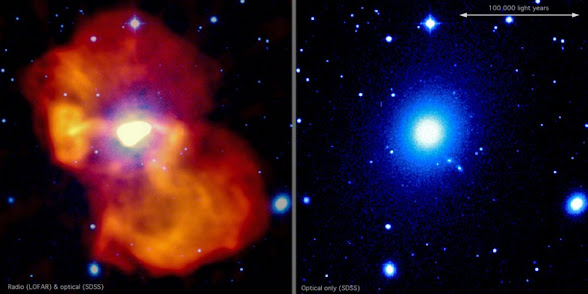Astronomers using the SRT ground-based radio telescope have built the most detailed radio map of the Andromeda Galaxy. It made it possible to better study the structure of the galaxy and its properties, as well as to compile a catalog of background sources.
The Andromeda Galaxy (or M31) is the largest galaxy in the Local Group and the closest spiral galaxy to the Milky Way. It is located at a distance of about 2.5 million light-years from our galaxy.
For astronomers, it is of interest both from the point of view of studying the processes of star formation and stellar dynamics and from the point of view of research in the field of formation and evolution of galaxies.
A team of astronomers led by Sofia Fatigoni from the University of British Columbia has built the most detailed map of the Andromeda Galaxy and its surroundings in the microwave frequency range of 1-22 gigahertz.
The observations were carried out using a 64-meter full-circle SRT (Sardinia Radio Telescope) radio telescope and took 66 hours. The goal of the scientists was to improve understanding of the morphology of the galaxy and the physical processes that go on inside it.
Once again, here is the brand new radio image of the Andromeda Galaxy. Credit: S. Fatigoni et al. / Astronomy & Astrophysics, 2021
Analysis of the data obtained by the SRT telescope, as well as data from the Effelsberg radio telescope and infrared maps of the galaxy made it possible to estimate the total star formation rate in the galaxy at 0.19 solar masses per year. The spiral arms of the galaxy are poorly distinguishable in the radio range, but a ring is visible that outlines the disk of M31.
Radiothermal radiation in the ring is associated with star formation processes, while in the central region of M31, free-free (bremsstrahlung) radiation may be associated with a high density of old stars like the Sun. Non-thermal radiation inside the ring is born as a result of the movement of particles of cosmic rays in a magnetic field in the interstellar medium of the galaxy. The nonthermal radiation profiles are uniform along the ring, which means that the field strength in the ring changes little.
At the same time, an unexpected fact was discovered – a correlation between the fluxes of nonthermal and microwave radiation in the bulge of the galaxy, which is unusual, since the processes of star formation there are slow.
Further observations should help establish the nature of this non-thermal radiation from the central region of M31. In addition, the researchers cataloged 93 point sources of radiation, such as stars, galaxies, and other objects visible against the backdrop of the Andromeda Galaxy, and identified five new candidates for supernova remnants in the galaxy.
With this said, here are 10 similar radio images of other significant objects in the universe.
Radio Image of the Centaurus A galaxy. Credit: NRAO/AUI/NSF/Univ.Hertfordshire/M.Hardcastle
ALMA radio image of galaxy NGC 4321 (Messier 100). Credit: ALMA (ESO/NAOJ/NRAO); NRAO/AUI/NSF, B. Saxton
Composite image from ALMA (orange) and Hubble (blue) of NGC 628 (Messier 74). Credit: NRAO/AUI/NSF, B. Saxton: ALMA (ESO/NAOJ/NRAO); NASA/Hubble
The core of Supernova 1987A imaged at radio wavelengths with ALMA. Credit: ALMA (ESO/NAOJ/NRAO), P. Cigan and R. Indebetouw; NRAO/AUI/NSF, B. Saxton; NASA/ESA
Radio images of the FIRST J1419+3940 gamma ray burst throughout the years. Credit: B. Saxton NRAO/AUI/NSF STScI, ROE, AAO, CalTech, National Geographic Society
Radio-only image of Abell 2744 in which you see features caused by accelerated particles from collisions between galaxy clusters. Credit: Pearce et al., NRAO/AUI/NSF
ALMA radio telescope image of the Antennae Galaxies. Credit: ALMA (ESO/NAOJ/NRAO)
LOFAR Radio Telescope images of galaxy M87. Credit: Francesco de Gasperin/LOFAR collaboration
Supernova remnant G55.7+3.4 seen in this radio image by the VLA. Credit: Bhatnagar et al., NRAO/AUI/NSF
Composite image of radio galaxy 3C321 with X-ray data (colored purple), optical and UV (red and orange) and radio emissions (blue). Credit: X-ray: NASA/CXC/CfA/D.Evans et al.; Optical/UV: NASA/STScI; Radio: NSF/VLA/CfA/D.Evans et al., STFC/JBO/MERLIN
Sources: Sci-News












